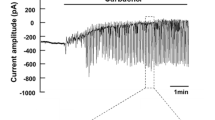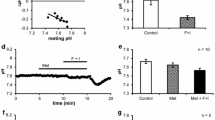Abstract
Our previously published whole-cell patch-clamp studies on the cells of the intralobular (granular) ducts of the mandibular glands of male mice revealed the presence of an amiloride-sensitive Na+ conductance in the plasma membrane. In this study we demonstrate the presence also of a Cl− conductance and we show that the sizes of both conductances vary with the Cl− concentration of the fluid bathing the cytosolic surface of the plasma membrane. As the cytosolic Cl− concentration rises from 5 to 150 mmol/liter, the size of the inward Na+ current declines, the decline being half-maximal when the Cl− concentration is approximately 50 mmol/liter. In contrast, as cytosolic Cl− concentration increases, the inward Cl− current remains at a constant low level until the Cl− concentration exceeds 80 mmol/liter, when it begins to increase. Studies in which Cl− in the pipette solution was replaced by other anions indicate that the Na+ current is suppressed by intracellular Br-, Cl− and NO -3 but not by intracellular I-, glutamate or gluconate. Our studies also show that the Cl− conductance allows passage of Cl− and Br- equally well, I-less well, and NO -3 , glutamate and gluconate poorly, if at all. The findings with NO -3 are of particular interest because they show that suppression of the Na+ current by a high intracellular concentration of a particular anion does not depend on actual passage of that anion through the Cl− conductance. In mouse granular duct cells there is, thus, a reciprocal regulation of Na+ and Cl− conductances by the cytosolic Cl− concentration. Since the cytosolic Cl− concentration is closely correlated with cell volume in many epithelia, this reciprocal regulation of Na+ and Cl− conductances may provide a mechanism by which ductal Na+ and Cl transport rates are adjusted so as to maintain a stable cell volume.
Similar content being viewed by others
References
Anderson, M.P., Sheppard, D.N., Berger, H.A., Welsh, M.J. 1992. Chloride channels in the apical membrane of normal and cystic flbrosis airway and intestinal epithelia. Am. J. Physiol. 263:L1-L14
Augustus, J., Bijman, J., Van Os, C.H., Siegers, J.F.G. 1977. High conductance in an epithelial membrane not due to extracellular shunting. Nature 268:657–658
Augustus, J., Bijman, J., Van Os, C.H. 1978. Electrical resistance of rabbit submaxillary main duct: A tight epithelium with leaky cell membranes. J. Membrane Biol. 43:203–226
Barry, P.H., Lynch, J.W. 1991. Liquid junction potentials and small cell effects in patch-clamp analysis. J. Membrane Biol. 121:101–117
Bijman, J. 1982. Transport Parameters of the Main Duct of the Rabbit Mandibular Salivary GLond. Ph.D. dissertation. University of Nijmegen, Nijmegen
Bijman, J., Cook, D.I., Van Os, C.H. 1983. Effect of amiloride on electrolyte transport parameters of the main duct of the rabbit mandibular salivary gland. Pfluegers Arch. 398:96–102
Cantiello, H.F., Patenaude, C.R., Codina, J., Birnbaumer, L., Ausiello, D.A. 1990. Gαi3 regulates epithelial Na+ channels by activation of phospholipase A2 and lipoxygenase pathways. J. Biol. Chem. 265:21624–21628
Dinudom, A., Young, J.A., Cook, D.I. 1993. Amiloride-sensitive Na+ current in the granular duct cells of mouse mandibular glands. Pfluegers Arch. 423:164–166
Foskett, J.K. 1990. [Ca2+]i, modulation of Cl− content controls cell volume in single salivary acinar cells during fluid secretion. Am. J. Physiol. 259:C998-C1004
Frömter, E., Gebier, B., Schopow, K., Pockrandt-Hemstedt, H. 1974. Cation and anion permeability of rabbit submaxillary main duct. In: Secretory Mechanisms of Exocrine Glands. N.A. Thorn, O.H. Petersen, editors. pp. 496–513. Munksgaard, Copenhagen
Garty, H., Civan, E.D., Civan, M.M. 1985. Effects of internal and external pH on amiloride-blockable Na+ transport across toad urinary bladder vesicles. J. Membrane Biol. 87:67–75
Garty, H., Asher, C., Yeger, O. 1987. Direct inhibition of epithelial Na channels by a pH-dependent interaction with calcium and other divalent ions. J. Membrane Biol. 95: 151–162
Hamill, O.P., Marty, A., Neher, E., Sakmann, B., Sigworth, F.J. 1981. Improved patch-clamp techniques for high resolution current recording from cells and cell-free membrane patches. Pfluegers Arch. 391:85–100
Knauf, H., Lübcke, R. 1975. Evidence for Na+ independent active secretion of K+ and K+ and HCO -3 by rat salivary duct epithelium. Pfluegers Arch. 361:55–60
Knauf, H., Wais, U., Lübcke, R., Albiez, G. 1976. On the mechanism of action of triamterene. Effects on transport of Na+, K+ and H+/HCO -3 ions. Eur. J. Clin. Invest. 6: 43–50
Knauf, H., Lübcke, R., Kreutz, W., Sachs, G. 1982. Interrelationships of ion transport in rat submaxillary duct epithelium. Am. J. Physiol. 242.-F132-F139
Neher, E. 1992. Correction for liquid junction potentials in patch clamp experiments. In: Ion Channels. Methods in Enzymology. B. Rudy and L.E. Iverson, editors. Volume 207, pp. 123–131. Academic, San Diego
Palmer, L.G., Frindt, G., Silver, R.B., Strieter, J. 1989. Feedback regulation of epithelial sodium channels. In: Cellular and Molecular Biology of Sodium Transport. Current Topics in Membranes and Transport. S.G. Schultz, editor. Volume 34, pp. 45–60. Academic, San Diego
Schneyer, L.H. 1970. Amiloride inhibition of ion transport in perfused excretory duct of rat submaxillary gland. Am. J. Physiol. 219:1050–1055
Turnheim, K., 1991. Intrinsic regulation of apical sodium entry in epithelia. Physiol. Rev. 71:429–445
Turnheim, K., Frizzell, R.A., Schultz, S.G. 1977. Effect of anions on amiloride-sensitive, active sodium transport across rabbit colon, in vitro. Evidence for “transinhibition” of the sodium entry mechanism. J. Membrane Biol. 37:63–84
Young, J.A., Van Lennep, E.W. 1978. The Morphology of Salivary Glands. Academic, London
Young, J.A., Cook, D.I., Van Lennep, E.W., Roberts, M.L. 1987. Secretion by the major salivary glands. In: Physiology of the Gastrointestinal Tract. L. Johnson, J. Christensen, M. Jackson, E. Jacobson, J. Walsh, editors. Volume 2, 2nd Edition, pp. 773–815. Raven, New York
Author information
Authors and Affiliations
Additional information
This project was supported by the National Health and Medical Research Council of Australia. We thank Professor P. Barry (University of New South Wales) for assistance with the junction potential measurements.
Rights and permissions
About this article
Cite this article
Dinudom, A., Young, J.A. & Cook, D.I. Na+ and Cl− conductances are controlled by cytosolic Cl− concentration in the intralobular duct cells of mouse mandibular glands. J. Membarin Biol. 135, 289–295 (1993). https://doi.org/10.1007/BF00211100
Received:
Revised:
Issue Date:
DOI: https://doi.org/10.1007/BF00211100




